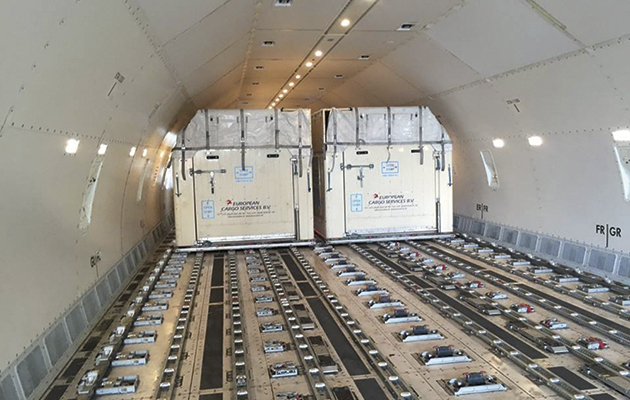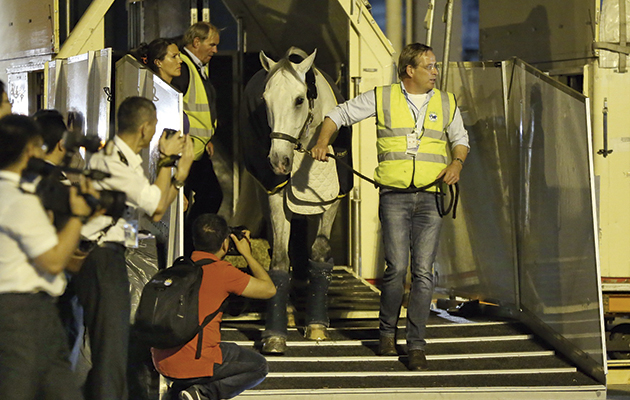The figures are mind-boggling: 311 equine athletes from across the globe, representing 50 nations, to be transported to Rio ready to deliver the performance of a lifetime. It’s an operation in which international shipping agency Peden Bloodstock can claim unrivalled expertise.
“This will be my eighth Olympics,” says managing director Martin Atock, whose team oversees the whole operation. “Our goal is not only to deliver the horses in peak competition fitness, but to ensure their health and welfare from the point of leaving their home stables to when they return.”
The shortlisted horses (233 for the Olympics and a further 78 for the Paralympics) have been readied for export as part of ongoing preparations. Blood tests for diseases including Glanders and West Nile virus have been submitted; vaccinations have been checked and lists of equipment, permitted feeds, supplements and veterinary medicines have been approved.
With paperwork finalised and passports and microchips in place, the journey can begin.
Air miles

Many of these elite-level horses are frequent flyers, so arriving at a busy airport should be nothing new.
“The horses are examined by an FEI vet at the airport before they leave,” says Martin. “This enables a swift transfer to the stables upon arrival in Brazil.”
The UK-based eventers will fly the 5,756 miles from Stansted, while dressage and showjumping horses depart from Liège in Belgium. Each Emirates Airlines 777 freighter carries around 34 horses, loaded into custom-built containers called air stables.
“The horses travel ‘business class’, in wide stalls that provide sufficient room for them to correct their balance,” says Martin. “This also allows much better airflow through the cargo bay. We don’t pack more horses in as the additional manure and urine produced would soon affect air quality.
“A considerable amount of body heat is generated by 34 eventers, each weighing roughly 520kg, so air temperature is maintained at 17°C.”
As there are no seatbelts to fasten during take-off, great care is taken not to knock these unsuspecting passengers off their feet.
“The aircraft uses the whole runway for take-off,” says Martin. “With live animals on board, transit must be smoother and gentler with no steep turns — it’s no different from driving a horsebox.”
Handling with care

An expert team on board comprises National Olympic Committee (NOC) vets and Peden’s flying grooms.
“The horses have the very best care and the optimum seats,” says Martin. “They’re monitored for signs of dehydration or colic; the grooms check them regularly and pre-empt problems where possible. Some teams give their horses intravenous fluids before the flight, but most drink well throughout the journey.”
In-flight catering is tailored for digestive health.
“We give them hay, positioned at a low level to keep their heads down to allow nasal discharge,” says Martin. “Hard feed increases the risk of constipation but a sloppy bran mash can be fed during the flight.
“These horses are experienced travellers and generally cope well,” he adds. “Only five or six of the 312 horses that flew to Hong Kong in 2008 had slightly raised temperatures upon arrival, all returning to normal within 24 hours.”
After a gradual descent into Rio Galeão (GIG) airport, the onboard team delivers the cargo to the waiting ground crew.
Martin explains: “The horses are lifted off the aircraft in their air stables before being unloaded and walked across the transfer ramp. After a brief visual veterinary inspection and with formalities completed, they’re loaded onto pre-screened trucks and driven the 26km to their stables at the Deodoro Olympic Park.”
The jet-setting athletes can then stretch their legs before being reunited with their grooms and settled into team camps. With luck, and a few steady days, they’ll be ready for the challenge ahead.
Flight data

How will the horses cope with an 11hr 20min journey and a four-hour time difference? Eventing team vet Liz Brown MRCVS, who will be on board with the horses, explains:
Circulation
Deep-vein thrombosis (DVT) is not a common problem. Because horses are standing, blood flow is not compromised by spending hours immobile in a seat. They wear travel boots and tail guards rather than bandages, however, because any “filling” during flight could make bandages tighten and cause circulation issues.
Air pressure
Chewing hay is the equine equivalent of sucking a sweet during take-off and landing — the swallowing action helps to equalise ear pressure and reduce any discomfort. A horse has bigger sinuses and a relatively large air space inside his head. Sinus pressure could be worsened by increased mucus levels, so we’ll be closely monitoring the horses we take to Rio for signs of airway problems.
Air in the bowel can expand, as it does in humans, which could lead to colic. We ensure that there are no trigger factors to increase gas build-up, such as overeating before the flight.
Turbulence
Flying is very much like standing in a stable for a horse, so most travel calmly. Minor turbulence is usually no worse than bumping over potholes in a horsebox. Reassuring an anxious horse is usually enough to settle him.
Jet lag
While they don’t share our diurnal rhythms, horses are thought to suffer some body clock disturbance. They do need to catch up on rest after a long flight. The equine body has evolved to snap into athletic work quite quickly, however, so they seem naturally able to adjust to different work patterns. They’ll have six days to acclimatise before the trot-up.
Living in a bubble
“A bio-security ‘bubble’, or ‘island’ is in effect an area where incoming competition horses are maintained in isolation from resident local horses for the duration of their temporary stay,” explains Dr Richard Newton of the Animal Health Trust.
“This extends to the routes by which the animals are brought in, including consideration given to transfers from aircraft and transport vehicles, and at stopovers, which may be potential weak links in the system. These measures are maintained until these animals depart the bubble in a similar, safe manner and move on to the next bubble — which may be their home premises.
“Whenever horses are moved internationally from a wide range of countries to one place for an event, and kept in relatively close proximity to one another for a period of time, spread of equine infectious diseases is a significant concern.
“The good news is disease prevention is eminently manageable through good biosecurity planning and implementation. Where possible, only healthy horses are transported. This relies on measures including high standards of vet care, health certification, use of isolation/quarantine/screening tests and vaccination.
“If local horses have been cleared from the Olympic site and there has been appropriate cleaning and disinfection, then the risk from Glanders and other equine diseases for these incoming animals should be extremely small. As long as all the associated measures for operating the ‘high health, high performance horse’ (HHP) concept are maintained, the Games should bring no greater risk of spread of equine infectious diseases.”
Ref: Horse & Hound; 28 July 2016

